Comparative Study of Cognitive Differences in Rural Landscapes Based on Eye Movement Experiments
Abstract
1. Introduction
1.1. Research on Rural Landscapes from Different Perspectives
1.2. Research on Rural Landscape Cognition
1.3. Classification Methods for Rural Landscape Image Elements
2. Materials and Methods
2.1. Sample Site Selection
2.2. Eye Movement Experiment
2.2.1. Selection of Experimental Photos
2.2.2. Selection of Subjects
2.2.3. Experimental Equipment and Environment
2.2.4. Process of Eye Movement Experiment
2.2.5. Data Handling of Eye Movement Experiment
2.3. Semi-Structured Interviews
2.3.1. Process of Semi-Structured Interviews
2.3.2. Data Handling of Semi-Structured Interview
3. Results
3.1. Analysis of Eye Movement Indicators
3.1.1. Analysis of Inter-Group Differences
3.1.2. Analysis of Intra-Group Differences
3.2. Analysis of Eye Movement Heat Maps
3.3. Analysis of Semi-Structured Interviews
- (1)
- Landmarks. The evaluation of the participants in the village group primarily revolved around Wangshang Village and the landmarks in the village, with a closely connected network of high-frequency words. Their key elements of focus were centered on objects within the immediate surroundings of each landmark, such as stone lions, streetlights, pedestals, war drums, signboards, and roadside trees. Approximately 80% of the participants shared numerous anecdotes during interviews that were related to their living memories. However, the evaluations of the participants in the tourist group revolved around the advantages and disadvantages of each landmark design, and the network formed between high-frequency words is relatively scattered. Their key elements of focus were mainly concentrated on a particular special component of each landmark, such as the roof of an archway, the plaque of the service center, or the inscriptions on landmark landscaping stones. Most tourists made evaluations based on local characteristics, personal experiences, cultural aesthetics, and other factors, and their comments were primarily related to local folklore, culture, traditions, as well as their initial impressions of Wangshang Village.
- (2)
- Edges. The evaluation of edges by the participants in the village group mainly revolved around their understanding and perception of the edges, with a relatively close network of high-frequency words. Their key elements of focus were scattered across the geographical locations, surrounding environments, and hardware facilities of the boundaries, and the evaluation dimensions were often related to the materials, locations, and shape characteristics of each edge. The evaluation of the participants in the tourist group centered on the recognizability of the edges, with a similarly close network of high-frequency words. Their key elements of focus were mostly on the appearance of each edge, such as fences, rivers, roads, hedges, or cliff faces. Most tourists evaluate the design of the edges from a critical perspective, with evaluation dimensions primarily encompassing the clarity, physical function, and potential design improvements for these edges.
- (3)
- Districts. The evaluation of the districts by the participants in the village group mainly revolved around the crops and several economic crop planting areas around the living area, with a relatively dispersed network of high-frequency words. Their key elements of focus were scattered across various locations within the kiwifruit-, onion-, and wheat-planting areas, and the evaluation dimensions were often linked to economic benefits. However, the evaluation of the districts by the tourist group participants mainly revolved around the characteristics and functions of the district, and the high-frequency word network is relatively scattered. Their primary focus tended to concentrate on specific aspects within the regions, such as a unique building within the residential area, the color of plants grown in the agricultural planting area, the materials used in the economic crop planting area, the trellises in the kiwifruit-planting area, or the shape of individual buildings in the homestay area. In addition, most tourists pointed out the dilemma of Wangshang Village lacking an industrial chain, and the evaluation dimensions were related to their suggestions for future design improvements.
- (4)
- Nodes. The evaluation of nodes by the participants in the village group mainly revolved around the node square within Wangshang Village, with a closely connected network of high-frequency words. Their key elements of focus were widely distributed across the plaque inscriptions on pavilions, the engravings on scenic walls, the size of water bodies, and the wooden walkways surrounding them. The evaluation dimensions were mostly related to the daily activities and habits of the local people. In addition, most middle-aged and elderly villagers raised demands for the maintenance and updating of related activity facilities. Compared with the participants in the village group, the evaluation of the tourist group participants mainly revolved around the styling characteristics of each node, and the high-frequency words also form a close network. Their attention was primarily concentrated on the distinctive individual components within each node plaza, such as pavilions, sculptures, tree pools, table tennis tables, water bodies, vegetation, or paving materials. The evaluation dimensions were mostly related to the advantages and disadvantages of node design, as well as subsequent design improvement suggestions.
- (5)
- Paths. The evaluation of paths by participants in the village group mainly revolved around the type, cleanliness, and daily habits of the paths, with a particularly tight network of high-frequency words. Their key elements of focus were widely dispersed across the surrounding environments on both sides of the roads, such as flower beds, streetlights, roadside trees, plant designs, residential buildings, and other facilities. Approximately 90% of villagers believed that compared to previous roads, the practicality and functionality of the various roads in the village had significantly improved. In contrast, the evaluation of the paths by the tourist group participants mainly revolved around the design, improvement, and enhancement measures of the paths themselves. Their main attention was often centered on the surface of each road or the various landscape elements at the end of the road, and the network formed between high-frequency words is relatively scattered.
4. Discussion
5. Conclusions
Author Contributions
Funding
Data Availability Statement
Acknowledgments
Conflicts of Interest
Appendix A
- (1)
- Dear Sir/Madam, thank you very much for participating in this experiment. During the experiment just now, which part did you pay the most attention to when observing each of the 5 landmarks photos? What aspects are most attractive to you? What elements require more time for you to observe? What is the viewing order of landscape elements in each photo? Please describe in detail. What is your opinion on the landmark design of Wangshang Village? Do you have any improvement suggestions?
- (2)
- During the experiment just now, which part did you pay the most attention to when observing each of the 5 edges photos? What aspects are most attractive to you? What elements require more time for you to observe? What is the viewing order of elements in each photo? Please describe in detail. What is your opinion on the edge design of Wangshang Village? Do you have any improvement suggestions?
- (3)
- During the experiment just now, which part did you pay the most attention to when observing each of the 5 districts photos? What aspects are most attractive to you? What elements require more time for you to observe? What is the viewing order of elements in each photo? Please describe in detail. What is your opinion on the district design of Wangshang Village? Do you have any improvement suggestions?
- (4)
- During the experiment just now, which part did you pay the most attention to when observing each of the 5 nodes photos? What aspects are most attractive to you? What elements require more time for you to observe? What is the viewing order of elements in each photo? Please describe in detail. What is your opinion on the node design of Wangshang Village? Do you have any improvement suggestions?
- (5)
- During the experiment just now, which part did you pay the most attention to when observing each of the 5 paths photos? What aspects are most attractive to you? What elements require more time for you to observe? What is the viewing order of elements in each photo? Please describe in detail. What is your opinion on the path design of Wangshang Village? Do you have any improvement suggestions?
References
- Kilos, T.; Primdahl, J.; Kristensen, L.S.; Busck, A.G. Introduction: Landscape change and rural development. Landsc. Res. 2010, 35, 571–576. [Google Scholar] [CrossRef]
- Liu, L.L.; Wu, R.N.; Lou, Y.R.; Luo, P.P.; Sun, Y.; He, B.; Hu, M.C.; Herath, S. Exploring the comprehensive evaluation of sustainable development in rural tourism: A perspective and method based on the AVC theory. Land 2023, 12, 1473. [Google Scholar] [CrossRef]
- Bartolini, F.; Vergamini, D. Introduction: Trade-offs and synergies between ecosystem services provided by different rural landscape. Agronomy 2023, 13, 997. [Google Scholar] [CrossRef]
- Yang, Q. Introduction: Research on the changes in cultural landscape of tourist-type traditional Chinese villages from the perspective of cultural memory: Taking Anshan Village in Chongqing as an example. Land 2023, 12, 816. [Google Scholar] [CrossRef]
- Xu, Z.Y. Research on the Planning and Design of Tourism Rural Landscape Trails. Master’ Thesis, Shandong Jianzhu University, Jinan, China, 2024. [Google Scholar]
- Zhao, Z.D. Research on Rural Tourism Landscape Planning and Design Based on Cultural Experience. Master’ Thesis, Henan Agricultural University, Zhengzhou, China, 2023. [Google Scholar] [CrossRef]
- Xie, H.L.; Zhu, Z.H.; He, Y.F.; Zeng, X.J.; Wen, Y.Y. Integrated framework of rural landscape research: Based on the global perspective. Landsc. Ecol. 2022, 37, 1161–1184. [Google Scholar] [CrossRef]
- Luo, W.B.; Lei, J.Q.; Shen, S.N.; Xu, F.X. Research on the influence mechanism of urban residents’ rural landscape cognition on tourism behavior intention. J. Hunan Fina. Econ. Univ. 2020, 36, 51–60. [Google Scholar] [CrossRef]
- Wang, X.C.; Luo, C.X.; Cai, W.T. Progress of Chinese Rural Landscape Characteristic System Research in Recent 20 Years. CHN Landsc. Arch. 2022, 38, 44–49. [Google Scholar] [CrossRef]
- Kim, E.-J.; Lim, C.; Choi, J. A Study on Planning Trails of Natural and Historic-Cultural Landscapes in Rural Villages. J. Kr. Soc. Rural Plan. 2014, 20, 159–171. [Google Scholar] [CrossRef]
- Zeng, X.G.; Zhao, Y.N. The Characteristics of Rural Settlement Landscape in Hilly Area from the Perspective of Ecological Environment. J. Coast. Res. 2020, 103, 506–510. [Google Scholar] [CrossRef]
- Li, W.W.; Zhou, Y.J.; Dai, X.G.; Hu, F. Evaluation of rural tourism landscape resources in terms of carbon neutrality and rural revitalization. Sustainability 2022, 14, 2863. [Google Scholar] [CrossRef]
- Yang, H.Y.; Wu, R.Z.; Qiu, B.; Zhang, Z.H.; Hu, T.Z.; Zou, J.H.; Wang, H. The next step in suburban rural revitalization: Integrated whole-process landscape management linking ecosystem services and landscape characteristics. Ecol. Indic. 2024, 126, 111999. [Google Scholar] [CrossRef]
- Cong, L.; Zhang, Y.J.; Su, C.H.; Chen, M.H.; Wang, J.N. Understanding tourists’ willingness-to-pay for rural landscape improvement and preference heterogeneity. Sustainability 2019, 11, 7001. [Google Scholar] [CrossRef]
- Li, M.X.; Yan, Y.; Ying, Z.Y.; Zhou, L. Measuring villagers’ perceptions of changes in the landscape values of traditional villages. ISPRS Int. J. Geo-Inf. 2024, 13, 60. [Google Scholar] [CrossRef]
- Chen, Z.F.; Wang, C.Y. The spatial ecological wisdom of rural landscape unit identification and cognition: A case study of Pai fang Community in Nanjing City. Landscape Arch. 2022, 29, 30–36. [Google Scholar] [CrossRef]
- Chen, H.; Guan, J.M.; Yang, H.T.; He, Y.X.; Zhu, B.; Chen, J. A review of domestic research on rural human settlement environment planning-Bibliometric and visual analysis based on CNKI academic journals. J. Manyang Tchr. Coll. 2022, 41, 117–123. [Google Scholar] [CrossRef]
- John, L. Land and Life: A Selection from the Writing of Carl Sauer, 1st ed.; University of California Press: Berkeley, CA, USA, 1963; pp. 12–15. [Google Scholar] [CrossRef]
- Dong, X. The significance, principles and index system of rural landscape classification. HM. Geo. 1990, 1990, 49–52+78. (In Chinese) [Google Scholar]
- Agnolotti, M. Rural landscape, nature conservation and culture: Some notes on research trends and management approaches from a (southern) European perspective. Landscape Urban Plan. 2014, 126, 66–73. [Google Scholar] [CrossRef]
- Torregiani, D.; Ludwiczak, Z.; Dall, A.E.; Benni, S.; Maino, E.; Tassinari, P. Trula: A high-resolution method for multi-time analysis of traditional rural landscapes and its application in Emilia-Romagna, Italy. Landsc. Urban Plan. 2014, 124, 93–103. [Google Scholar] [CrossRef]
- Dupont, L.; Ooms, K.; Antro, M.; Reveled, V.V. Comparing saliency maps and eye-tracking focus maps: The potential use in visual impact assessment based on landscape photographs. Landsc. Urban Plan. 2016, 148, 17–26. [Google Scholar] [CrossRef]
- Su, T.T.; Wang, K.P.; Li, S.S.; Wang, X.Y.; Li, H.; Ding, H.R.; Chen, Y.F.; Liu, C.H.; Liu, M.; Zhang, Y.L. Analysis and Optimization of Landscape Preference Characteristics of Rural Public Space Based on Eye-Tracking Technology: The Case of Huangshan Dian Village, China. Sustainability 2023, 15, 212. [Google Scholar] [CrossRef]
- Grindsted, A. Interactive resources used in semi-structured research interviewing. J. Pragma. 2005, 37, 1015–1035. [Google Scholar] [CrossRef]
- Gugu, P.C.; Rodríguez-Campos, L. Semi-structured interview protocol for constructing logic models. Eval. Program Plan. 2007, 30, 339–350. [Google Scholar] [CrossRef] [PubMed]
- Guo, S.L.; Zhao, N.X.; Zhang, J.X.; Xue, T.; Liu, P.X.; Xu, S.; Xu, D.D. Research Landscape visual quality assessment based on eye movement: College student eye-tracking experiments on Hongcun tourism landscape pictures. Res. Sci. 2017, 39, 1137–1147. (In Chinese) [Google Scholar]
- Duan, H.L.; Han, L. Research on the development of rural tourism. Res. Dev. Mkt. 2000, 5, 314–315. (In Chinese) [Google Scholar]
- Wang, Y.C.; Liu, B.Y. On Chinese rural landscape and rural landscape planning. CHN. Landscape Arch. 2003, 1, 56–59. (In Chinese) [Google Scholar]
- Liu, Y.F. A Study on the Imagery of Urban Historical Landscape in the Old City of Beijing, 1st ed.; Science Press: Beijing, China, 2019; pp. 23–25. [Google Scholar]
- Lynch, K. The Image of the City, 1st ed.; Fang, Y.; He, X., Translators; Huaxia Publishing House: Beijing, China, 2001; pp. 37–66. [Google Scholar]
- Liu, J.Y.; Li, L.M. Notice of the general office of the ministry of agriculture and rural affairs on the announcement of beautiful leisure villages in China in 2020. China Agric. Yearb. 2020, 2020, 521–524. [Google Scholar]
- Ma, L.; Xu, Y.Z.; He, S.Y.; Tang, Z.; Li, T.Z. Exploring cognition differences in the traditional village landscape based on eye-tracking experiment. Urban Dev. Stud. 2023, 30, 86–94. (In Chinese) [Google Scholar]
- Yang, M.M. Eye-Tracking and Chinese Reading, 1st ed.; Social Science Literature Publishing House: Beijing, China, 2018; pp. 36–56. [Google Scholar]
- Zhao, Y.; Lin, J.H.; Liu, Y. Research on visual evaluation of tourism scenery based on eye movement experiment: A case of Tangjia Ancient Town in Zhuhai. Human Geography. 2020, 35, 130–140. [Google Scholar] [CrossRef]
- Wu, C.J.; Min, Y.C.; Fei, B.H.; Song, S.S. A study on the aesthetic preference of bamboo weaving patterns based on eye movement experiments. Buildings 2023, 13, 1558. [Google Scholar] [CrossRef]
- Zhang, T.; Liu, D.D.; Zhang, H.W.; Huang, L.F. Landscape Aesthetic Experience of Longi Rice Terraces based on the Eye-Tracking Experiment. South Arch. 2023, 2023, 52–61. (In Chinese) [Google Scholar]
- Mead, W.R. The Iconography of Landscape: Essays on the Symbolic Representation, Design and Use of Past Environments; Cambridge University Press: Cambridge, UK; Cosgrove, D., Daniels, S., Eds.; 1989; Volume 155, p. 129. [Google Scholar] [CrossRef]
- Wang, M. Eye Movement Analysis for Landscape Visual Quality Evaluation—A Case Study of Danxia Landform in Sunan, Gansu Province. Ph.D. Thesis, Nanjing University, Nanjing, China, 2011. [Google Scholar]
- Zhao, J.Z.; Yan, Y.; Deng, H.B.; Liu, G.H.; Dai, L.M.; Tang, L.N.; Shi, L.Y.; Shao, G.F. Remarks about land senses ecology and ecosystem services. Int. J. Sust. Dev. World 2020, 27, 196–201. [Google Scholar] [CrossRef]
- Treichler, D.G. Are you missing the boat in training aid? Film AV Comm. 1967, 1, 14–16. [Google Scholar]
- Amati, M.; Parmer, E.G.; McCarthy, C.; Sita, J. How eye-catching are natural features when walking through a park? Eye-tracking responses to videos of walks. Urban For. Urban Green. 2018, 31, 67–78. [Google Scholar] [CrossRef]
- Meidenbauer, L.K.; Stenfors, U.C.; Young, J.; Layden, E.A.; Schertz, K.E.; Kardan, O.; Decay, J.; Berman, M.G. The gradual development of the preference for natural environments. J. Environ. Psychol. 2019, 65, 101328. [Google Scholar] [CrossRef]
- Van Den Berg, A.E.; Vlei, C.A.J.; Couturier, J.F. Group differences in the aesthetic evaluation of nature development plans: A multilevel approach. J. Environ. Psychol. 1998, 18, 141–157. [Google Scholar] [CrossRef]
- Muro, R.S.T.; Granados, C.S.D.; Romero, E.J.R. Green infrastructures in the peri-urban landscape: Exploring local perception of well-being through ‘Go-Along’ and ‘Semi-Structured Interviews’. Sustainability 2020, 12, 6836. [Google Scholar] [CrossRef]
- Johnson, M.L.; Campbell, L.K.; Svendsen, E.S.; McMillen, H.L. Mapping urban park cultural ecosystem services: A comparison of twitter and semi-structured interview methods. Sustainability 2019, 11, 6137. [Google Scholar] [CrossRef]
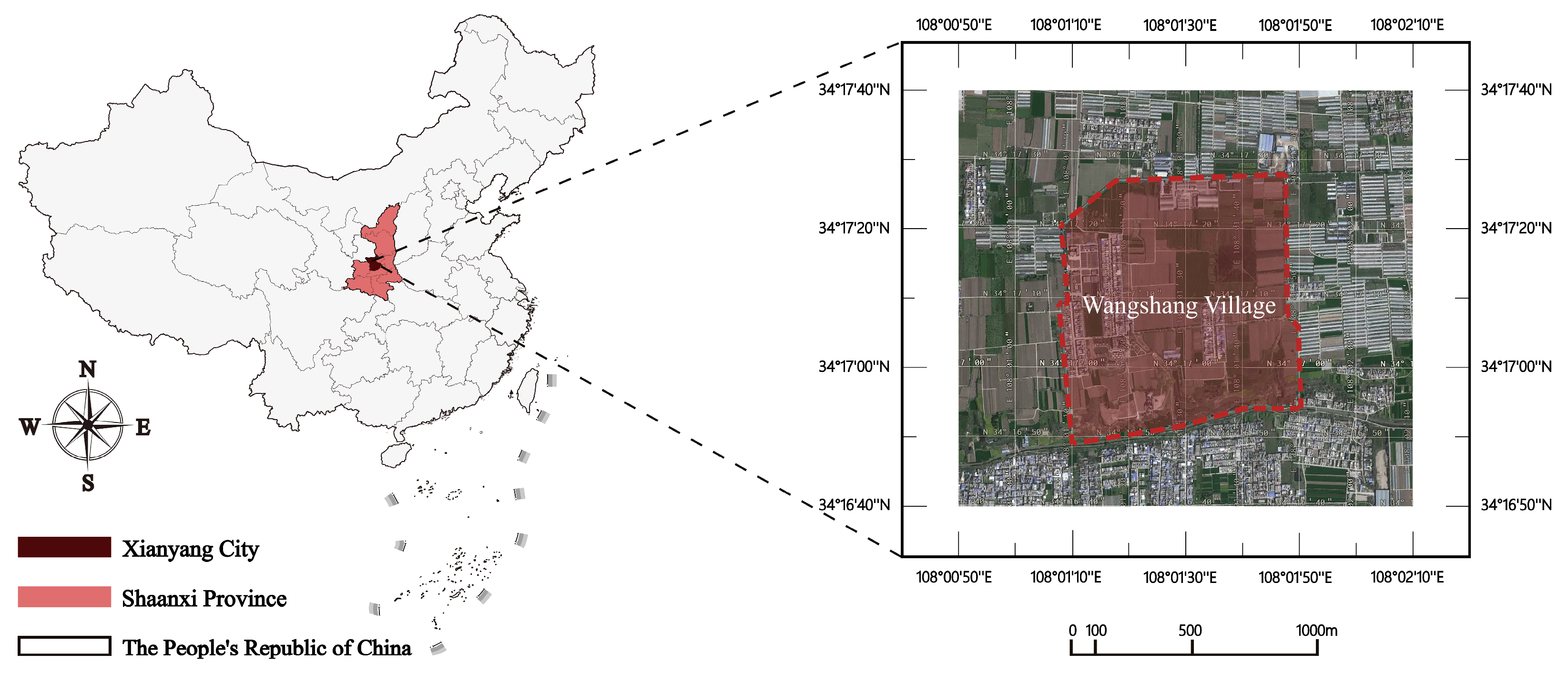
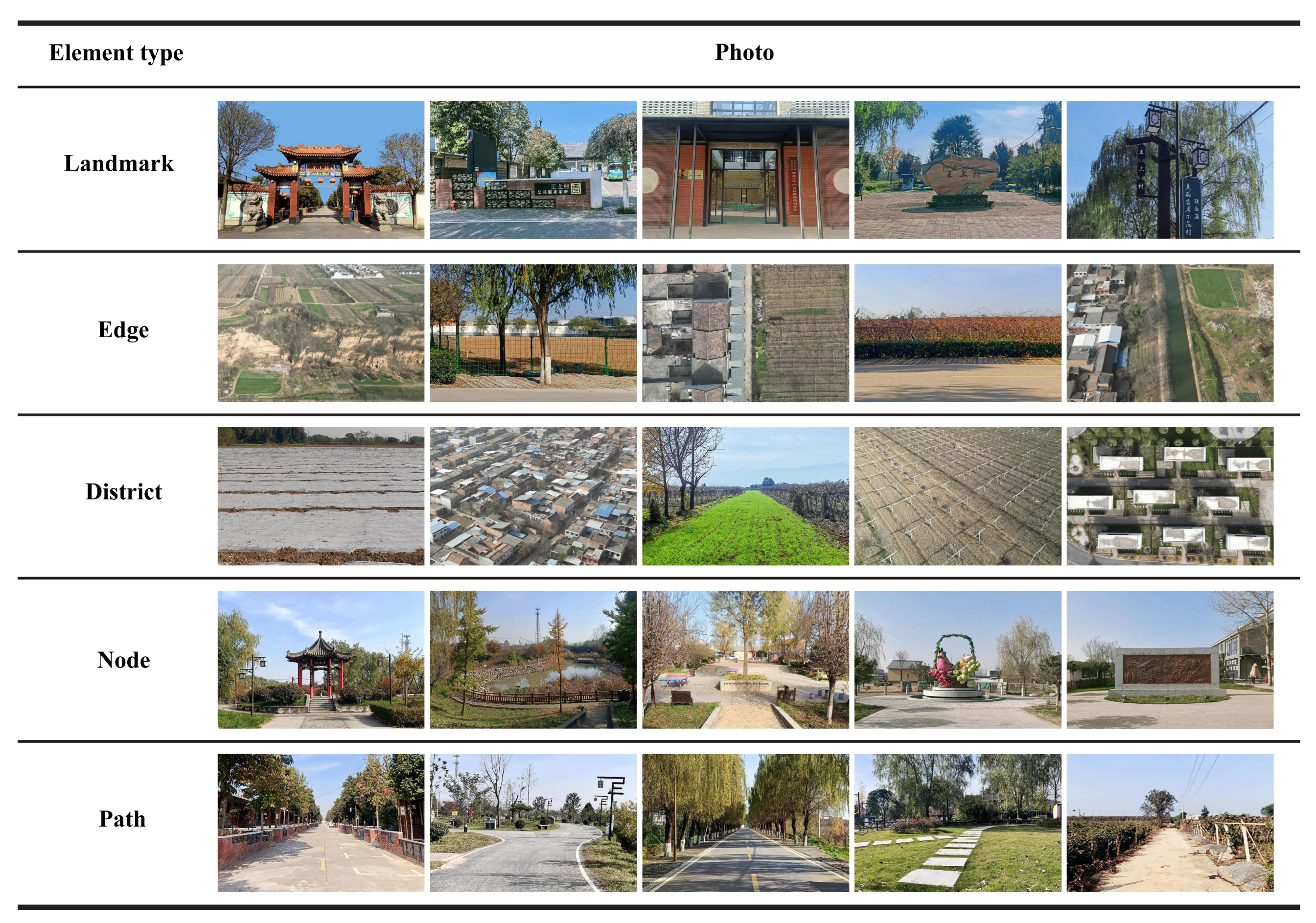
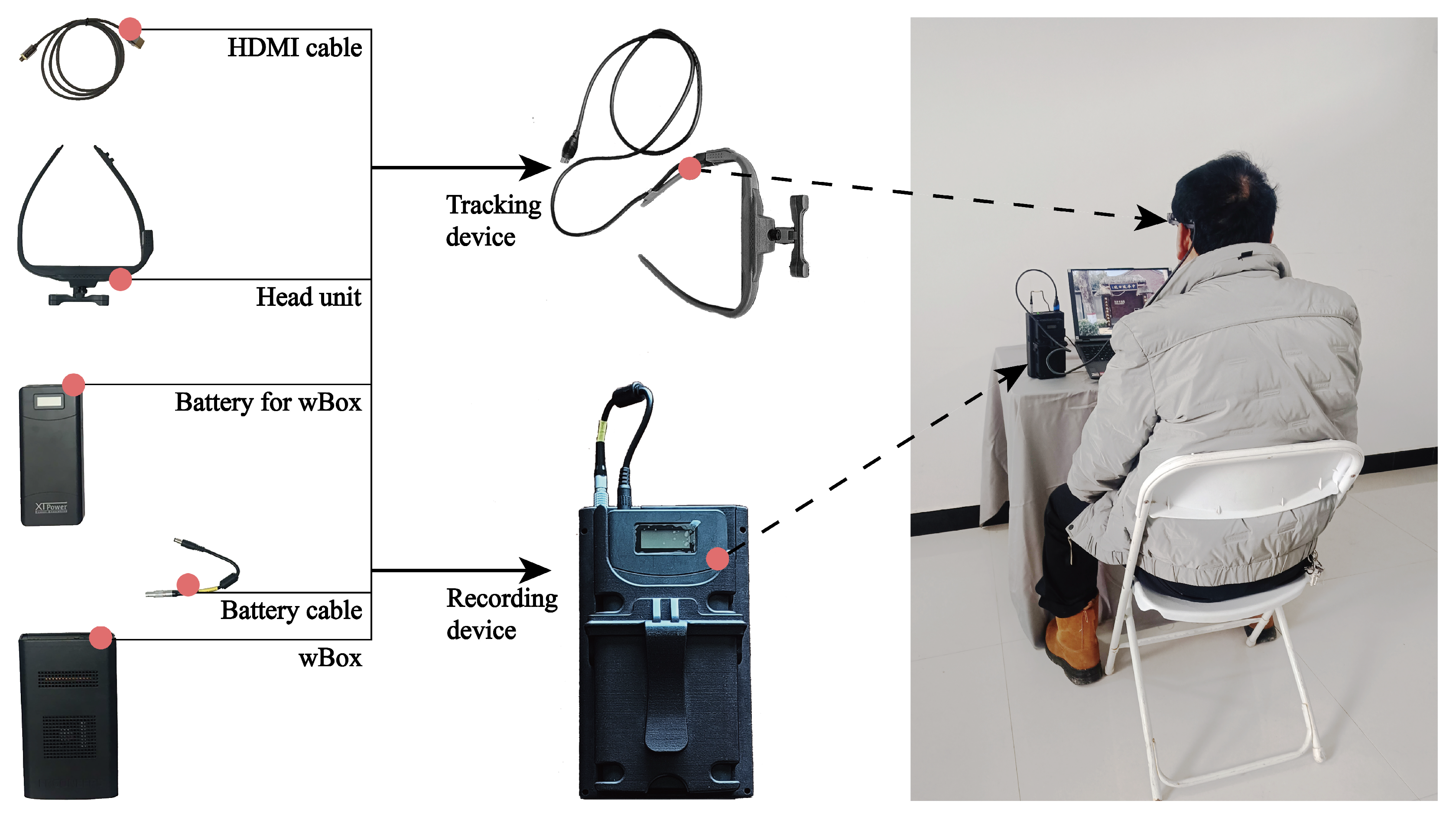
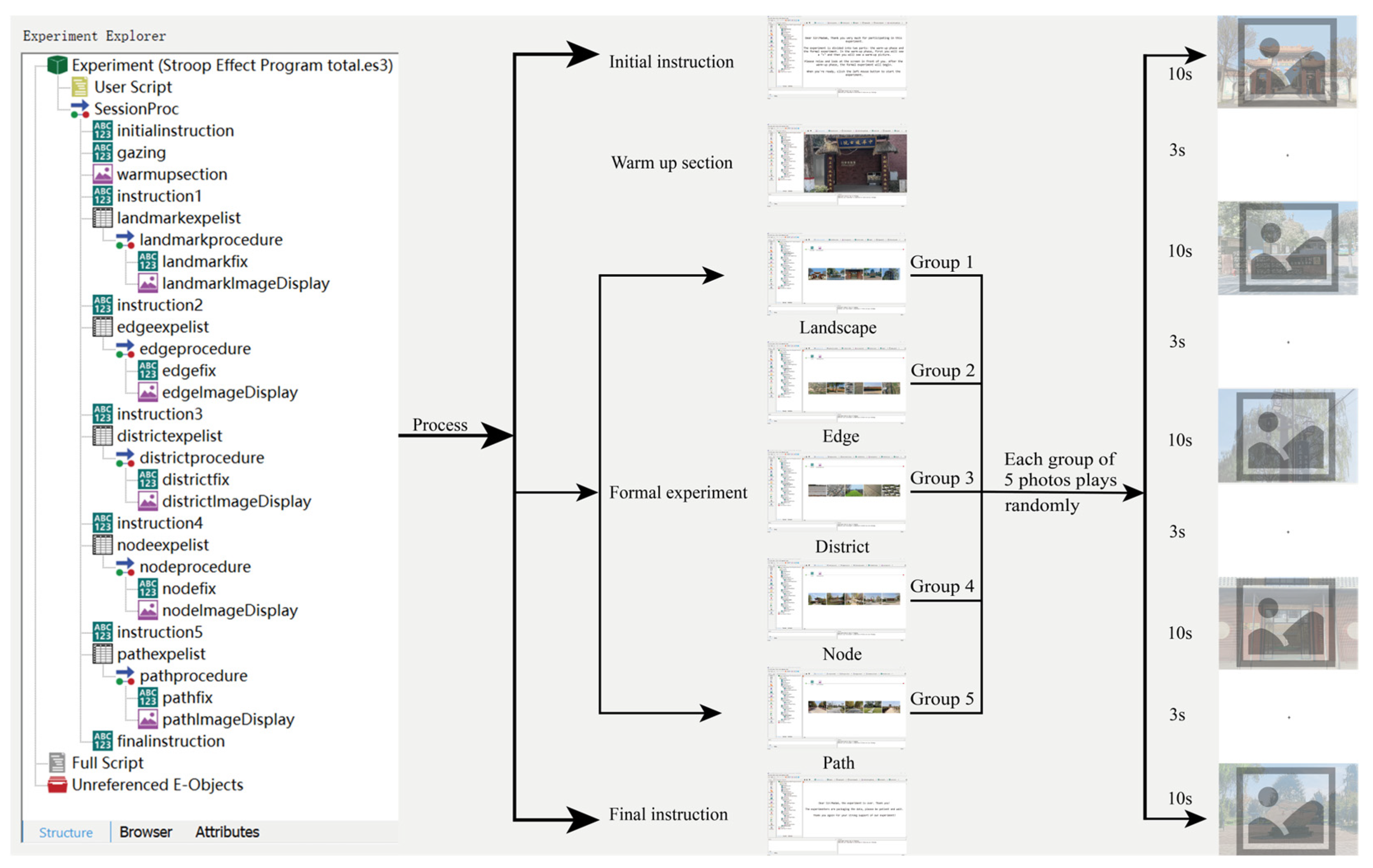

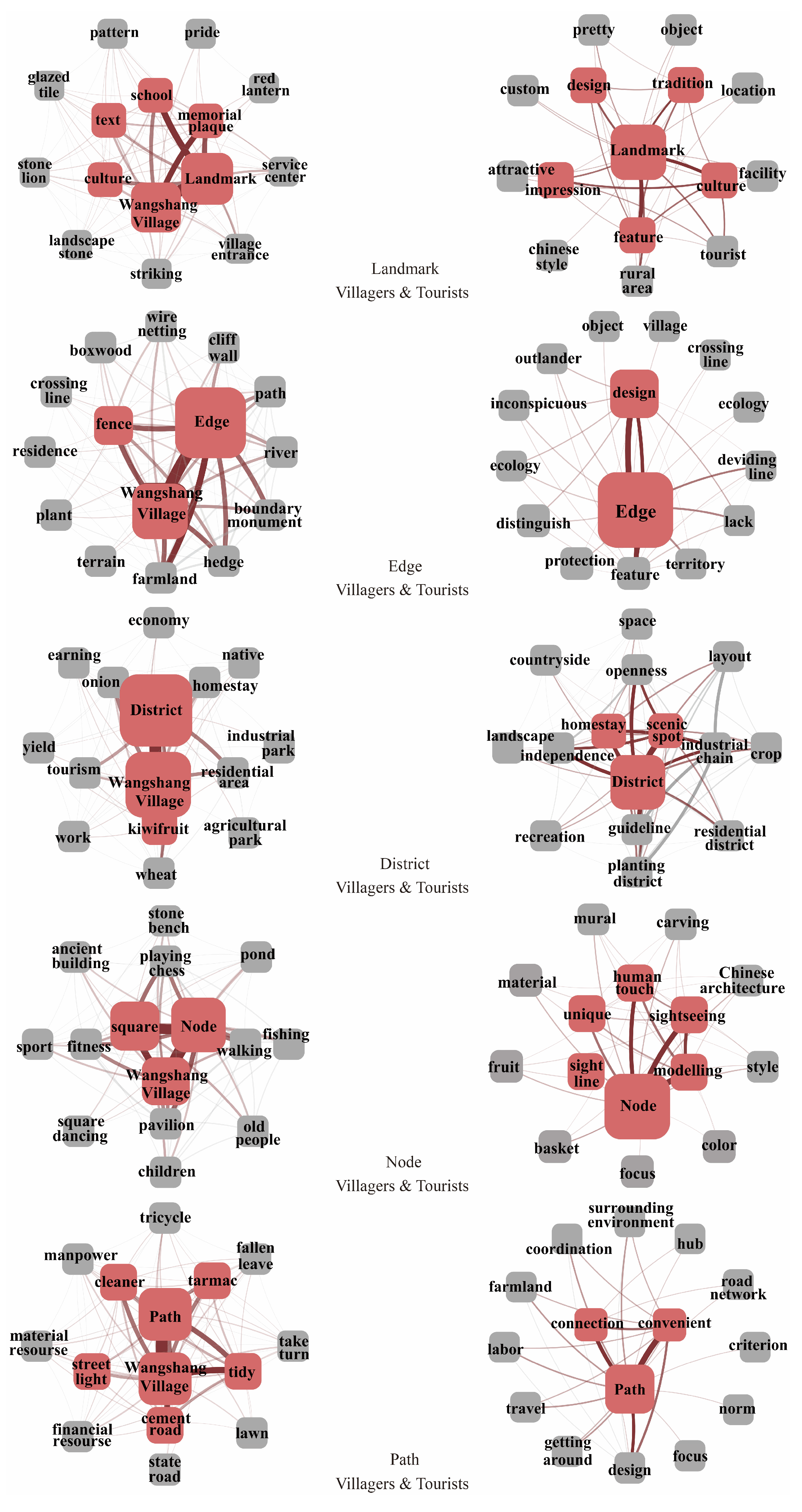
| Group | Mann–Whitney U Test Results | |||||
|---|---|---|---|---|---|---|
| Average Fixation Points/No./Person | Z | p | Average Fixation Time/s/Person | Z | p | |
| Villagers | 11.418 | −1.183 | 0.237 | 0.588 | −5.530 | 0.001 *** |
| (8.800, 14.220) | (0.475, 0.898) | |||||
| Tourists | 11.820 | 0.771 | ||||
| (9.400, 13.680) | (0.568, 1.105) | |||||
| Element Type | Group | Mann–Whitney U Test Results | |||||
|---|---|---|---|---|---|---|---|
| Average Fixation Points/No./Person | Z | p | Average Fixation Time/s/Person | Z | p | ||
| Landmark | Villagers | 11.628 (8.700, 14.300) | −0.462 | 0.644 | 0.621 (0.466, 1.045) | −4.820 | 0.001 *** |
| Tourists | 11.464 (8.300, 13.800) | 0.803 (0.536, 1.147) | |||||
| Edge | Villagers | 11.381 (8.200, 14.800) | −2.203 | 0.028 ** | 0.555 (0.428, 0.898) | −5.620 | 0.001 *** |
| Tourists | 12.214 (9.900, 15.500) | 0.749 (0.505, 0.961) | |||||
| District | Villagers | 11.583 (7.800, 15.300) | −0.873 | 0.383 | 0.604 (0.479, 0.923) | −4.156 | 0.001 *** |
| Tourists | 11.894 (8.100, 14.200) | 0.778 (0.515, 1.431) | |||||
| Node | Villagers | 11.211 (8.600, 14.900) | −1.933 | 0.053 | 0.556 (0.416, 0.878) | −5.451 | 0.001 *** |
| Tourists | 11.933 (7.700, 14.500) | 0.762 (0.504, 1.164) | |||||
| Path | Villagers | 11.289 (8.300, 13.900) | −0.975 | 0.770 | 0.603 (0.462, 0.973) | −3.367 | 0.001 *** |
| Tourists | 11.594 (7.300, 15.000) | 0.764 (0.490, 1.652) | |||||
| Group | Kruskal–Wallis H Test Results | |||||
|---|---|---|---|---|---|---|
| Average Fixation Points/Number/Person | Average Fixation Time/Second/Person | |||||
| M | SD | p | M | SD | p | |
| Villagers | 11.418 | 1.642 | 0.742 | 0.588 | 0.129 | 0.019 ** |
| Tourists | 11.820 | 1.572 | 0.347 | 0.711 | 0.191 | 0.365 |
| Group | Element Type Sample Pairing | Average Fixation Points (Significance/p) | Average Fixation Time (Significance/p) |
|---|---|---|---|
| Villagers | Landmark-Edge | 0.471 | 0.009 ** |
| Landmark-District | 0.973 | 0.224 | |
| Landmark-Node | 0.248 | 0.003 ** | |
| Landmark-Path | 0.373 | 0.392 | |
| Edge-District | 0.554 | 0.156 | |
| Edge-Node | 0.681 | 0.411 | |
| Edge-Path | 0.933 | 0.220 | |
| District-Node | 0.338 | 0.039 ** | |
| District-Path | 0.389 | 0.884 | |
| Node-Path | 0.791 | 0.080 | |
| Tourists | Landmark-Edge | 0.039 ** | 0.215 |
| Landmark-District | 0.164 | 0.173 | |
| Landmark-Node | 0.162 | 0.260 | |
| Landmark-Path | 0.408 | 0.057 | |
| Edge-District | 0.800 | 0.937 | |
| Edge-Node | 0.612 | 0.796 | |
| Edge-Path | 0.282 | 0.417 | |
| District-Node | 0.951 | 0.884 | |
| District-Path | 0.414 | 0.417 | |
| Node-Path | 0.681 | 0.305 |
Disclaimer/Publisher’s Note: The statements, opinions and data contained in all publications are solely those of the individual author(s) and contributor(s) and not of MDPI and/or the editor(s). MDPI and/or the editor(s) disclaim responsibility for any injury to people or property resulting from any ideas, methods, instructions or products referred to in the content. |
© 2024 by the authors. Licensee MDPI, Basel, Switzerland. This article is an open access article distributed under the terms and conditions of the Creative Commons Attribution (CC BY) license (https://creativecommons.org/licenses/by/4.0/).
Share and Cite
Wang, Y.; Li, K.; Li, J.; Hao, T.; Zhou, Z. Comparative Study of Cognitive Differences in Rural Landscapes Based on Eye Movement Experiments. Land 2024, 13, 1592. https://doi.org/10.3390/land13101592
Wang Y, Li K, Li J, Hao T, Zhou Z. Comparative Study of Cognitive Differences in Rural Landscapes Based on Eye Movement Experiments. Land. 2024; 13(10):1592. https://doi.org/10.3390/land13101592
Chicago/Turabian StyleWang, Yanbo, Kankan Li, Jiaxin Li, Tiange Hao, and Zhishu Zhou. 2024. "Comparative Study of Cognitive Differences in Rural Landscapes Based on Eye Movement Experiments" Land 13, no. 10: 1592. https://doi.org/10.3390/land13101592
APA StyleWang, Y., Li, K., Li, J., Hao, T., & Zhou, Z. (2024). Comparative Study of Cognitive Differences in Rural Landscapes Based on Eye Movement Experiments. Land, 13(10), 1592. https://doi.org/10.3390/land13101592







